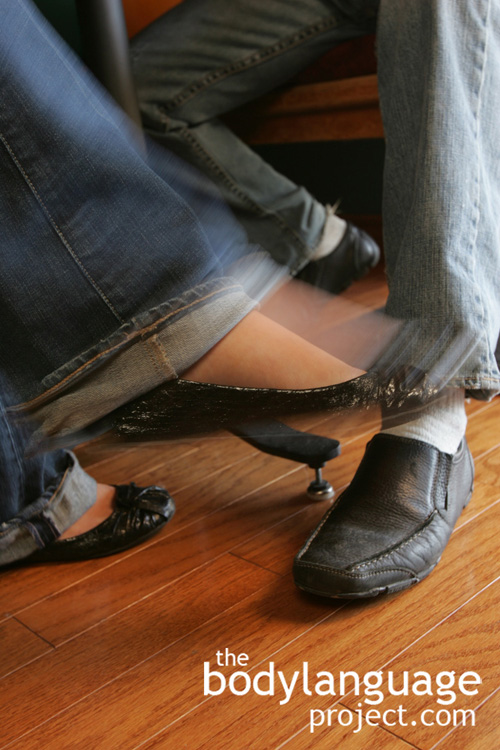Body Language of Foot Fidgeting
Synonym(s): Fidgeting Feet, Foot Bouncing, Bouncing Feet, Leg Bounce, Foot Jiggling
Description: Foot fidgeting is a repetitive motion of the foot. It will move up and down, back and forth, or in a circular manner usually while seated with the legs crossed. The feet might also cause the leg to bump up and down while seated with the legs uncrossed. Feet can also tap up and down while standing, or move in, out, and away, while seated.
In One Sentence: Foot jiggling signifies that a person has extra energy that they need to burn off.
How To Use it: Use foot jiggling to relieve the tension of being nervous and also to help deal with the discomfort of being sessile for long periods of time. Women can also jiggle their feet while wearing high heel shoes and a skirt to draw attention to sexy legs that are crossed tightly. Putting the body in motion draws attention to the parts which are moving.
Context: a) General b) Dating.
Verbal Translation: a) “I’m jiggling my leg because I have so much extra energy and you are boring me and I want to leave.” b) “I’m bouncing my leg up and down to draw attention to my sexy legs and capture your attention.”
Variant: See Cooperative Feet, Toe Pointing or Pointed Toe, Frozen Hands or Frozen Feet, Happy Feet.
Cue In Action: The lecture just kept dragging on and on. You could tell by the amount of leg jiggling that the students were ready to get out of there.
Meaning and/or Motivation: a) Feet kick when escape is not possible as a way the body prepares for action. Women have been known to do the same thing, even bouncing a leg up and down and squeeze their upper thighs tightly together which can even result in orgasm. Not every leg bounce with tight leg crossing produces orgasm though, yet this form of soothing still produces comfort, and quite likely a dose of oxytocin to boot!
b) Other times, a woman will bounce her foot up and down with legs crossed to draw attention to her sexuality. Legs in motion draw the eyes in and captures the attention of men. The foot fidgeting, in this case, is due to sexual excitement and the readiness to take action.
Cue Cluster: Foot fidgeting is usually coupled with face touching, arm touching, smoothing clothing, eyes averted, chin supported by the hand, tapping the pen to the mouth, fidgeting with papers, looking at watches and other boredom signals. To read leg bounce as sexual energy, watch for additional sexual cues in cluster.
Body Language Category: Autoerotic touching, Boredom, Closed body language, Courtship displays, Disengagement, Energy Displacement, Indicators of disinterest (IOD), Indicators of sexual interest (IOsI), Intention movements, Metronomic signals, Microgestures, Nervous body language.
Resources:
Almerigogna, Jehanne; James Ost; Lucy Akehurst and Mike Fluck. How Interviewers’ Nonverbal Behaviors Can Affect Children’s Perceptions And Suggestibility. Journal of Experimental Child Psychology. 2008. 100:17-39.
http://bodylanguageproject.com/articles/get-children-tell-truth-using-body-language/
Burba, Nathan ; Bolas, Mark ; Krum, David M. ; Suma, Evan A.. Unobtrusive measurement of subtle nonverbal behaviors with the Microsoft Kinect. 2012 IEEE Virtual Reality. 2012. 1-4.
Clifford, Ruth. Development of masturbation in college women. Archives of Sexual Behavior. 1978. 7(6): 559-573.
de Bruijn G. From masturbation to orgasm with a partner: how some women bridge the gap–and why others don’t. J Sex Marital Ther. 1982. 8(2):151-67.
Farley, James; Risko, Evan F; Kingstone, Alan. Everyday Attention And Lecture Retention: The Effects Of Time, Fidgeting, And Mind Wandering. Frontiers In Psychology, 2013; 4: 619
http://bodylanguageproject.com/articles/mind-wandering-fidgeting-and-attention/
Gregersen, Tammy S. Nonverbal Cues: Clues to the Detection of Foreign Language Anxiety. Foreign Language Annals. 2005. 38(3): 388-400
http://bodylanguageproject.com/articles/what-anxious-learners-can-tell-us-about-anxious-body-language-how-to-read-nonverbal-behavior/
Hatz, Jessica L. and Martin J. Bourgeois. Anger as a Cue to Truthfulness. Journal of Experimental Social Psychology. 2010. 46: 680-683.
http://bodylanguageproject.com/articles/anger-nonverbal-cue-truth-telling/
Hall, Jeffrey A. and Chong Xing. The Verbal and Nonverbal Correlates of the Five Flirting Styles. Journal of Nonverbal Behavior. 2015. 39:41–68. DOI 10.1007/s10919-014-0199-8
http://bodylanguageproject.com/articles/first-12-minutes-flirting-using-nonverbal-communication-study-reveals-26-body-language-cues-attraction/
Kinsey, A. C., Pomeroy, W. B., Martin, C. E., and Gebhard, P. H. (1953). Sexual Behavior in the Human Female, Saunders, Philadelphia.
Katza, Carmit; Irit Hershkowitz; Lindsay C. Malloya; Michael E. Lamba; Armita Atabakia and Sabine Spindlera. Non-Verbal Behavior of Children Who Disclose or do not Disclose Child Abuse in Investigative Interviews. Child Abuse & Neglect. 2012. 36: 12-20.
http://bodylanguageproject.com/articles/reading-nonverbal-behaviour-child-abuse-cases-encourage-children-divulge-information-truth-telling
Leanne ten Brinke; Dayna Stimson and Dana R. Carney. Some Evidence For Unconscious Lie Detection. Published online before print March 21, 2014, doi: 10.1177/0956797614524421.
http://bodylanguageproject.com/articles/to-spot-a-liar-trust-your-gut-not-your-eyes/
Navarro, Joe. 2008. What Every BODY is Saying: An Ex-FBI Agent’s Guide to Speed-Reading People. William Morrow Paperbacks.
Rothman, Naomi B. Steering Sheep: How Expressed Emotional Ambivalence Elicits Dominance in Interdependent Decision Making Contexts. Organizational Behavior and Human Decision Processes. 2011. 116: 66-82.
http://bodylanguageproject.com/articles/ambivalent-facial-expression-form-dominance-study/
Sturman, Edward D. Invluntary Subordination and Its Relation to Personality, Mood,
and Submissive Behavior. Psychological Assessment. 2011. 23(1): 262-276 DOI: 10.1037/a0021499
http://bodylanguageproject.com/articles/nonverbal-submission-men-women-depression-critical-examination-use-disuse-submission/
Sporer, Siegfried L. ; Schwandt, Barbara Penrod, Steven D. (editor). MODERATORS OF NONVERBAL INDICATORS OF DECEPTION: A Meta-Analytic Synthesis.
Psychology. Public Policy, and Law. 2007. 13(1): 1-34.
Seli, Paul; Jonathan S. A. Carriere; David R. Thomson; James Allan Cheyne, Kaylena A. Ehgoetz Martens, and Daniel Smilek. Restless Mind, Restless Body Journal of Experimental Psychology: Learning, Memory, and Cognition. American Psychological Association. 2014. 40(3): 660-668. 0278-7393/14/$12.00 DOI: 10.1037/a0035260
http://bodylanguageproject.com/articles/fidgeting-body-language-really-mean-fidget-bored-mentally-taxed/
Van Der Zee, Sophie; Ronald Poppe; Paul J. Taylor; and Ross Anderson. To Freeze or Not to Freeze A Motion-Capture Approach to Detecting Deceit.
http://bodylanguageproject.com/articles/detect-lies-whole-body-nonverbals-new-lie-detector-successful-using-body-language-70/

